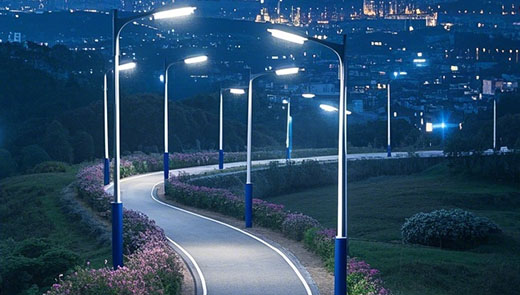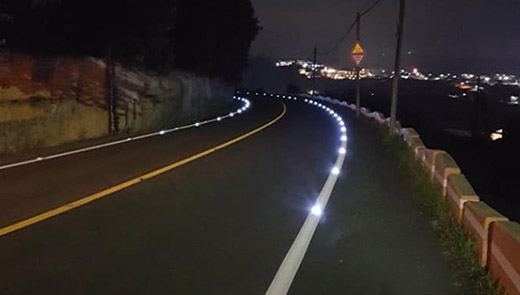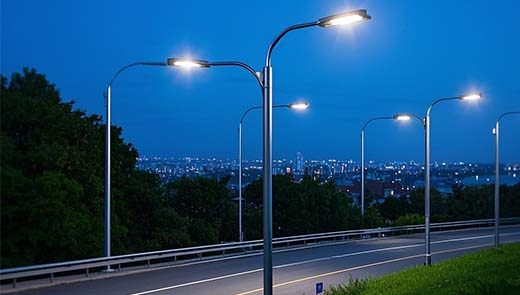Do solar street lights charge on rainy days?
In today's era of vigorously advocating green environmental protection, solar street lights are widely used in urban and rural streets and alleys by virtue of their low-carbon and energy-saving features. However, every rainy day, we inevitably have doubts: solar street lights in the rainy days can charge? Below, we will analyze this issue in depth.

How solar street lights operate?
The operation of solar street lights is inseparable from the photovoltaic panel. During the day, the photovoltaic panel absorbs sunlight and converts it into electricity with the help of photoelectric effect. Photons hit the semiconductor material inside the photovoltaic panel, prompting the flow of electrons, which in turn forms an electric current. The electricity generated is stored in a battery. When night falls, the battery releases the electrical energy to provide stable power for the street light to illuminate the road. The performance of a solar streetlight is affected by the PV panel, the battery and the electronic management system. The conversion efficiency of the photovoltaic panel, the capacity of the battery, and the stability of the electronic management system all determine whether the street light can operate stably.
Can solar street lights work normally on rainy days?
Using indirect light to realize charging
Even if the sunlight is blocked by clouds on a rainy day, solar street lights can still work. Photovoltaic panels do not only rely on direct sunlight, but also generate electricity by capturing indirect sunlight scattered by clouds. What's more, modern photovoltaic technology has dramatically improved its ability to capture different light spectra, ensuring that charging is possible even in low-light environments.
Technology upgrades improve rainy day adaptability
With technological advances, many solar street lights have significantly improved their performance in low-light environments by optimizing PV panel design and materials. The charging efficiency of some advanced photovoltaic panels in rainy days has been improved by about 30% compared with traditional products, which guarantees the power supply of street lights in bad weather.
Understanding the effect of rain on solar street lights
Waterproof grade guarantees normal operation
In order to cope with all kinds of weather, solar street lights are equipped with a certain degree of waterproof capability. Internationally, IP protection level is used to measure its waterproof and dust proof performance. IP44 grade solar street light can prevent water splash and some dust from entering, applicable to indoor or dry outdoor; IP65 grade can resist water splash and a lot of dust, applicable to regular outdoor scenes; IP67 grade can be immersed in water for a short period of time, applicable to watery environments. It is recommended to choose IP65 and above to ensure its normal operation in rainy days.
Long-term rain erosion poses hidden danger
Although the solar street light is waterproof, it may still have problems if it is exposed to rainwater for a long time. Rainwater may enter the interior through the gaps or poor sealing of the housing, damaging key components such as batteries and circuit boards, and triggering short-circuiting or malfunctioning of the street light. Long-term erosion of rainwater will cause corrosion of the metal parts of the street light, which not only affects the appearance, but also weakens the structural strength and reduces the overall performance.
Factors Influence the charging performance of solar street lights
Light conditions
Direct sunlight is the best charging light source for solar street lights, and the output power of photovoltaic panels can reach its peak value under direct sunlight. Studies have shown that the charging efficiency of PV panels can be significantly increased by about 50% under direct sunlight compared to indirect light. This means that sufficient direct sunlight allows solar street lights to store more power in a shorter period of time to meet nighttime lighting needs. For example, on a clear summer day with direct sunlight, the street light can collect a large amount of power in just a few hours.
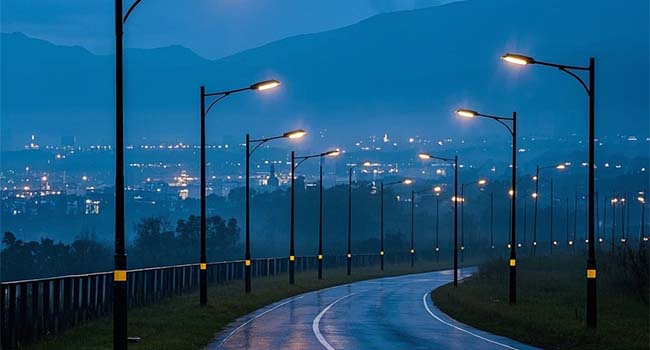
Shade, such as trees and buildings, can drastically reduce the amount of sunlight received by PV panels, resulting in a significant reduction in charging efficiency. For example, when half of a PV panel is shaded, its charging efficiency may drop to less than 30% of its original capacity. Therefore, when installing solar street lights, it is important to choose the installation location carefully, and try to avoid areas with the risk of shading, so as to ensure that the PV panels can fully and directly receive sunlight. If the street light is installed in an inappropriate location that is shaded by a building, the charging efficiency will be greatly reduced, as in the case of urban streets with many tall buildings.
Weather conditions
Rainy, cloudy and foggy days and other inclement weather will greatly reduce the intensity of sunlight, resulting in a significant decline in the charging efficiency of solar street lights. In rainy days, for example, the intensity of sunlight received by the PV panels is only 10% - 30% of that received in sunny days due to cloud cover, making the charging process very slow. Persistent rainy weather also makes it difficult to fill the solar street light battery, affecting the subsequent lighting duration and stability. A week of consecutive rain can cut a streetlight's nightly lighting duration in half.
PV panel quality
High-quality photovoltaic panels utilize advanced materials and manufacturing processes, resulting in higher conversion efficiencies under various lighting conditions. Compared with low-quality PV panels, high-quality products can increase charging efficiency by 20% - 30% under low-light conditions. For example, some PV panels made of monocrystalline silicon are far superior to polycrystalline silicon PV panels in terms of performance under low light conditions. Moreover, high-quality PV panels are more resistant to aging and weathering, and can maintain stable performance over a long period of time. street lights using monocrystalline silicon PV panels can still maintain high charging efficiency after 5 years, while the performance of polycrystalline silicon PV panels decreases significantly.
PV panel cleanliness
The accumulation of dust, dirt and debris on the surface of PV panels can seriously block sunlight and significantly reduce charging efficiency. Tests have shown that when the surface of a PV panel is covered with 10% dirt, its charging efficiency may drop by about 15%. Therefore, regular cleaning of PV panels to keep the surface clean is essential to improve the performance of solar street lights in rainy days and low-light conditions. In industrially polluted areas, if not cleaned in a timely manner, the PV panels will soon be covered with dirt and the charging efficiency will be drastically reduced.
Battery performance
Battery capacity directly determines the amount of power stored in a solar street light. Large-capacity batteries can store more power to ensure that the street light can still work normally under continuous rainy weather. For example, a 100Ah capacity battery can provide longer lighting under the same conditions than a 50Ah capacity battery. For three consecutive days of rain, a streetlight with a 100Ah battery can be illuminated normally, while a streetlight with a 50Ah battery may go out earlier.
High-quality batteries are not only more efficient in charging and discharging, but also have a longer service life. Compared with low-quality batteries, the charging and discharging efficiency of high-quality products can be increased by 10%-20%, and the service life can be extended by 2-3 years. High-quality batteries can maintain better performance in different temperature environments, reducing the impact of temperature changes on charging and discharging. High-quality lithium batteries can be stably charged and discharged at both high and low temperatures, while ordinary lead-acid batteries are more affected by temperature.
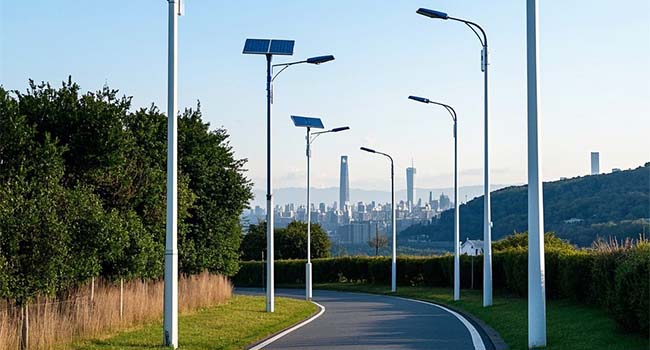
Temperature factor
Extreme high or low temperatures can adversely affect the charging performance of solar street lights. High temperature will reduce the conversion efficiency of PV panels, when the ambient temperature exceeds 40℃, the charging efficiency of PV panels will decrease by 10% - 15%. This is because high temperatures will change the rate of electron migration within the PV panel, affecting its power generation capacity. Low temperature will seriously affect the battery charging and discharging performance, when the temperature is lower than 0 ℃, the battery discharge capacity will be reduced by 20% - 30%, this is due to the low temperature of the internal chemical reaction rate of the battery slows down, resulting in the battery can not be normal release and storage of electrical energy. In hot desert areas, high temperatures in summer can reduce the efficiency of PV panels; in cold northern winters, low temperatures can affect battery performance.
Equipment aging
With the increase of use time, the components of solar street light will gradually aging, resulting in the decline of charging performance. Generally speaking, after 3-5 years of use, the conversion efficiency of PV panels may decrease by 10% - 20%, and the battery capacity will be reduced accordingly. Therefore, regular maintenance of solar street lights and timely replacement of aging parts is the key to maintain the performance of street lights. Some street lights that have been in use for more than 5 years are obviously experiencing shorter lighting hours and reduced brightness.
Strategies to improve the charging performance of solar street lights in rainy days
Optimize installation location
Choose a sunny and unobstructed installation location so that the PV panels can receive the maximum amount of sunlight. When actually installing, comprehensively consider factors such as the surrounding terrain, building distribution and tree growth. Even on rainy days, sufficient indirect sunlight can provide some power support for street lights. Simulation software can also be used to analyze the light conditions at different installation locations to determine the best installation point. When planning the installation of street lights in new neighborhoods, professional software simulation can be used to find the best location for light.
Adjusting the angle of photovoltaic panels
According to the local geographical latitude and seasonal changes, adjust the angle of the photovoltaic panels so that they can better receive sunlight. Adjusting the angle appropriately on rainy days can significantly improve the PV panel's ability to capture scattered light. For example, in the northern hemisphere, the angle of the PV panel can be adjusted upward in winter to increase the sunlight receiving area. Some solar street lights are equipped with automatic tracking systems, which can automatically adjust the angle of the PV panel according to the position of the sun, further improving the charging efficiency. Some high-end solar street lights can track the sun's position in real time, always maintaining the optimal angle of the PV panels.
Keep PV panels clean
Regularly clean the surface of the PV panels to remove dust, dirt and debris to ensure that the sunlight can fully irradiate the PV panels. When cleaning, use a soft brush and water, and avoid scratching the panel surface with sharp tools. This is especially important on rainy days, when rain may wash dust and dirt onto the surface of the PV panels, creating a shield. Automatic cleaning devices can also be installed to clean the PV panels regularly, saving labor costs. In dusty areas, installing an automatic cleaning device will keep the PV panels clean continuously.
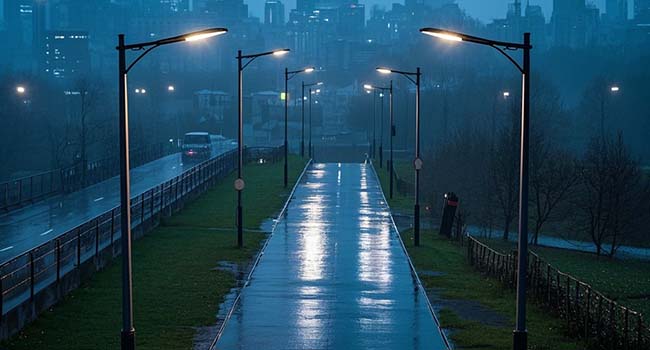
Choose high quality products
Purchase high-quality solar street lights with advanced technology and high-quality materials, which can maintain good performance in various weather conditions, and the charging efficiency and working stability are more guaranteed in rainy days. When choosing products, pay attention to the conversion efficiency of photovoltaic panels, battery capacity and quality, as well as street light protection level and other parameters.
For example, choose photovoltaic panels with a conversion efficiency of more than 20%, and lithium batteries with large capacity and long life. At the same time, choose a well-known brand products, its product quality and after-sales service is more secure. Famous brands of solar street lights have been rigorously tested, reliable performance, and can solve problems in a timely manner after the sale.
Monitor the battery status
Regularly check the battery charging status to find and solve problems in time. Intelligent monitoring system can be installed to monitor the battery voltage, current and remaining power and other parameters in real time. When the battery power is found to be too low under continuous cloudy and rainy weather, the battery can be replenished by backup power or other charging methods. It can also reasonably adjust the working mode of the street light according to the battery usage to prolong the service life of the battery. Some intelligent street light systems can view the battery status in real time through cell phone APP, which is convenient for management and maintenance.
Upgrade photovoltaic panels
When conditions allow, you can consider upgrading photovoltaic panels and choose products with higher power and efficiency. For example, upgrade the traditional polycrystalline silicon photovoltaic panels to monocrystalline silicon photovoltaic panels, or use new high-efficiency photovoltaic materials. Upgraded photovoltaic panels can significantly improve the charging capacity of solar street lights in low-light conditions, effectively solving the problem of insufficient charging on rainy days.
The number of photovoltaic panels can also be increased to further improve the charging efficiency in combination with the actual demand. After upgrading the old polycrystalline silicon PV panels to monocrystalline silicon, the charging efficiency in rainy days can be increased by more than 30%.
Use of energy-saving mode
Some solar street lights are equipped with energy-saving modes, which can automatically adjust the brightness according to the ambient light and battery power. In rainy days or under low-light conditions, the energy-saving mode can be activated to reduce power consumption by lowering the brightness of the streetlight and extend the working time of the streetlight. Some street lights are also equipped with intelligent dimming functions, which can automatically adjust the brightness of street lights according to the surrounding traffic flow and pedestrian activities, realizing more precise energy-saving control. Late at night, when there are fewer cars and people, the street light automatically reduces the brightness, saving electricity.
Maintenance points of solar street light in rainy days
Select high-quality products
Purchase solar street lights with high protection level and sturdy structure, which can effectively resist rain and bad weather erosion. Choose street lights made of stainless steel or high-strength plastic to improve durability.
Conduct regular inspections
Regularly inspect the streetlight housing, seals and connection parts to detect and repair damaged or aging parts in time. Before and after the rainy season, it is even more important to carry out thorough inspection and maintenance.
Ensure proper installation and cleaning
Ensure that the solar street light is installed correctly and the PV panels are facing the best light direction. Meanwhile, clean the PV panels and street light housing regularly to maintain the equipment in good condition.
Solar street lights can charge and work properly in rainy days. Although rain and low light will affect the charging performance, its performance in rainy days can be maximized through reasonable design, installation and maintenance. Choosing high-quality products, optimizing the installation location, and regular maintenance can ensure the stable operation of solar street lights in all kinds of weather. As an environmentally friendly and energy-saving lighting equipment, solar street light will surely play a greater role in the future with the advancement of technology.

